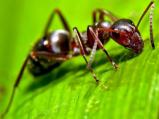

Pests
Antex is able to provide solutions for any pest problem. Below you will find a partial list of the pests that we can help you control. This is a list of the most common pests that we encounter, if you do not see what you are looking for below please call. Ants
Carpenter ants nests are found in wood. In the home they target beams & wood supports, leaving behind sawdust. They do not eat the wood, just chew through it. Left unchecked they can cause thousands of dollars worth of damage. Bed Bugs
Bed Bugs
Because they are wingless, bed bugs are unable to clime metal or polished surfaces, and are unable to fly or jump. They feed off blood from animals and humans mostly at night while we sleep. Because of the shape of their bodies they can hide in small locations, such as mattress pads, box springs, electrical outlets etc. The female lays her eggs in crevices and cracks in hidden locations. Newly hatched, they feed as soon as food is available Black Carpet Beetles
Black Carpet Beetles
The black carpet beetle will feed on stored foods as well as most plant and animal derived products including leather and fabrics. They are hard to locate as they like to eat and nest in hidden locations and will continue to grow and cause considerable damage. They have a ferocious appetite and will eat almost anything in their path. Cockroaches
Cockroaches
There are more than 3,500 species around the world but the most common household species is the German cockroach in our area. They thrive in warm moist conditions where food and water are available, such as restaurants, food processing facilities, basement, bathrooms and household kitchens. They can contaminate food and spread disease by walking over areas where food is prepared. They are nocturnal, and could remain unseen for long periods of time. Fleas
Fleas
A flea’s hind legs are so powerful, it can jump distances up to 200 times its body length. They cause discomfort, annoyance and irritation not only to humans, but pets as well. They suck blood and usually feed several times a day. They have been known to survive several weeks without food. Infestation outdoors is early August to early October. Mature fleas leave the host after eating, but leave behind eggs, larvae found on pets. It is a known fact that they can transmit diseases. Mice
Mice
There are two types of mice: The house mouse is light brown to dark grey in colour with very large ears. The deer mouse is grey or brown with white belly and feet, and the underside of its tail is white. They both carry disease, and cause considerable damage to property. They can squeeze through cracks as small as a dime. They multiply rapidly, so should be eradicated as quickly as possible. Rats
Rats
The most common rats found native to B.C on Vancouver Island is the Norway rat, and the Black rat better known as the roof rat. The female can have up to 7 litters per year of 8-12 pups per litter. They damage homes and buildings by chewing on insulation, and siding and only needs a quarter size hole to enter in. They can start fires by chewing on wires causing electrical shortages. Rats also consume and contaminate large amounts of stored food and can transmit diseases on their feet and in their urine. Spiders
Spiders
The venom from a black widow spider is 15 times more poisonous than that of a rattlesnake, but, the amount of venom a spider injects with one bite is usually not fatal for humans. They prefer dark, sheltered spots close to the ground to spin their web. A female can lay 50 – 100 eggs onto a small web and cover them with silk for protection, until they hatch in 30 days. Brown Recluse Spider
Brown Recluse Spider
It is brown in colour and hides in dark, secluded places like under porches or deep in closets, hence, its name. It is 3/8 of an inch long, and approx. 3/16th of an inch wide. Reactions to their bite depends on the amount of venom injected. You may experience a delayed reaction, an immediate reaction, or no reaction at all. A small red mark appears but heals quickly, leaving no scars. Hobo Spider
Hobo Spider
Hobo spiders are uncommon above basements or ground level and rarely climb vertical surfaces. Nesting sites are usually where dead wood is found. Their bite is usually painless, but can be serious. If venom is injected, immediate redness will develop around the bite. Eventually a blister will appear and break open, leaving an oozing ulceration. It can take up to 45 days to heal, and permanent scaring can occur. Silverfish
Silverfish
Silverfish’s main habitat is mainly in warm moist areas, such as basements and attics, although they do live outdoors as well. Their diet consists of starchy foods high in carbohydrates and protein, such as in glue, book bindings, paper, photos, sugar, coffee, hair, carpets clothing etc. They can live approximately two to eight years. Due to their destruction of property and consumption of food, they are household pests, but do not transmit disease. They have been known to live without food for a year or more. Termites
Termites
Annually, new colonies of termites are reproduced. It is difficult to distinguish between flying ants and termites. It is most important to determine the difference, as termites are most destructive and can do extreme damage to your home as they feed mostly on wood. Colonies of termites live underground, and come to the surface seeking food. If they are exposed to the atmosphere for any length of time they will die. Wasps
Wasps
Most commonly called “wasps”, they can be identified by their markings and colour. They nest mostly in trees & shrubs, or in soil cavities. Their stinger has small barbs which occasionally becomes lodged and pulls free from its body and deposits venom to its attacker. If provoked, they can become aggressive, and will sting repeatedly causing severe pain. The peak season for Yellow Jackets is May to August.
 home
home
 contact
contact
 About Us
About Us
 Pest
Pest
 Ladysmith Homemove
Ladysmith Homemove


